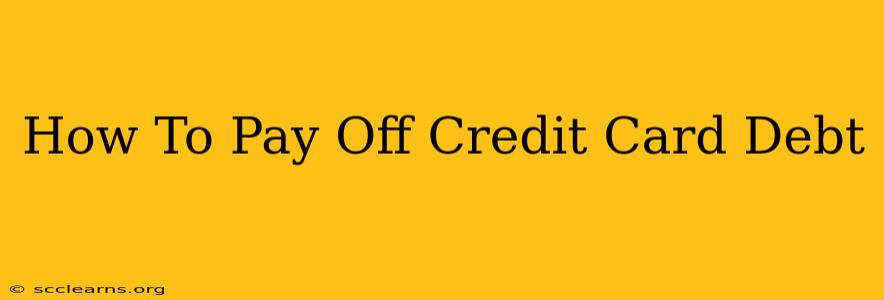Credit card debt can feel overwhelming, but with a strategic plan and consistent effort, you can conquer it. This guide provides a step-by-step approach to tackling your credit card debt and regaining financial freedom.
Understanding Your Debt
Before you can start paying off your debt, you need to understand the full picture. This involves:
- Listing all your credit cards: Write down the name of each credit card, its current balance, the interest rate (APR), and the minimum payment.
- Calculating your total debt: Add up all your outstanding credit card balances to determine your total debt. This gives you a clear picture of the challenge ahead.
- Analyzing your spending habits: Honestly assess where your money is going. Identify areas where you can cut back to free up funds for debt repayment. Using budgeting apps or spreadsheets can be incredibly helpful here.
Strategies for Paying Off Credit Card Debt
Several effective strategies can help you pay off your credit card debt faster and more efficiently. Choose the one that best suits your financial situation and personality.
1. The Avalanche Method
This method prioritizes paying off the card with the highest interest rate first, regardless of the balance. By tackling the highest interest debt first, you'll save money on interest in the long run.
- Pros: Saves the most money on interest.
- Cons: Can be demotivating if you have a large balance on a high-interest card.
2. The Snowball Method
This method focuses on paying off the smallest debt first, regardless of the interest rate. Once the smallest debt is paid off, you roll the payment amount into the next smallest debt, creating a "snowball" effect.
- Pros: Provides quick wins and boosts motivation, making it easier to stick to the plan.
- Cons: Might cost more in interest compared to the avalanche method.
3. The Balance Transfer Method
This involves transferring your high-interest balances to a credit card with a 0% introductory APR. This gives you time to pay down the debt without accruing additional interest. Be aware of balance transfer fees and make sure you pay off the balance before the introductory period ends, otherwise, you'll be charged the card's regular high interest rate.
- Pros: Allows you to pay down the principal balance without accruing interest during the introductory period.
- Cons: Requires good credit, balance transfer fees may apply, and you must pay off the debt within the promotional period.
Tips for Success
- Create a Realistic Budget: Track your income and expenses to identify areas where you can cut spending.
- Increase Your Income: Explore opportunities to earn extra money, such as a side hustle or part-time job.
- Automate Payments: Set up automatic payments to ensure you consistently make your minimum payments.
- Avoid New Debt: Refrain from opening new credit cards or taking on additional debt while you're paying off your existing balances.
- Seek Professional Help: If you're struggling to manage your debt, consider seeking help from a credit counselor.
Conclusion
Paying off credit card debt takes time and discipline, but it's achievable. By following these strategies, creating a realistic budget, and staying committed to your plan, you can become debt-free and achieve greater financial stability. Remember, consistency and patience are key to success!
Keywords: credit card debt, pay off credit card debt, debt repayment, debt reduction, avalanche method, snowball method, balance transfer, credit card payoff, financial freedom, budgeting, debt management.

